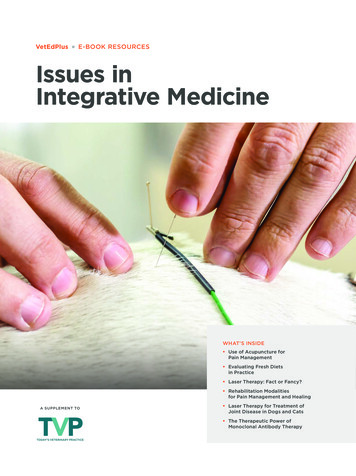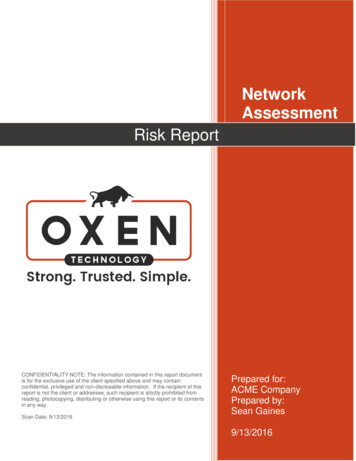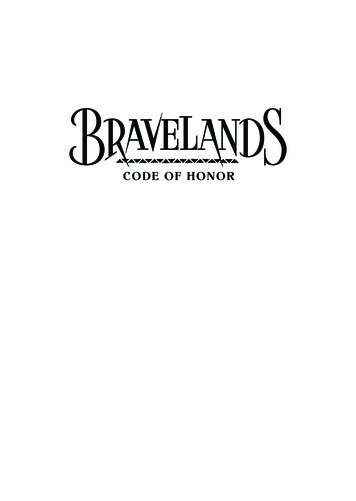
Transcription
VetEdPlusE-BOOK RESOURCESIssues inIntegrative MedicineWHAT’S INSIDE Use of Acupuncture forPain Management Evaluating Fresh Dietsin Practice Laser Therapy: Fact or Fancy? Rehabilitation Modalitiesfor Pain Management and HealingA SUPPLEMENT TO Laser Therapy for Treatment ofJoint Disease in Dogs and Cats The Therapeutic Power ofMonoclonal Antibody Therapy
E-BOOKPEER REVIEWEDUse of Acupuncturefor Pain ManagementRonald Koh, DVM, MS, CVA, CVCH, CVFT, CCRP, Assistant ProfessorLouisiana State University School of Veterinary Medicine, Baton Rouge, LouisianaAcupuncture is a safe, nonpharmacologic interventionwith minimal adverse effects that most animals toleratewell.2,3 It has become more accepted for pain relief inveterinary medicine. In fact, the pain managementguidelines published by the American Animal HospitalAssociation, American Association of FelinePractitioners, and World Small Animal VeterinaryAssociation endorse acupuncture as a safe adjuncttreatment for pain management in dogs and cats thatshould be strongly considered as a part of a multimodalpain management regimen.4,5Acupuncture can be used independently or integratedinto conventional analgesia protocols. It has significantanalgesic effects on inflammatory, neuropathic, cancer,and visceral pain states.6 It can help ease acute painfrom neuromusculoskeletal injuries and surgery, as wellas chronic spinal and osteoarthritic pain. Veterinaryclinical trials also provide evidence for omHOW DOES ACUPUNCTURE WORK?Acupuncture is the stimulation of certain points on thebody that correspond to neurovascular bundles, bloodplexuses, sites of nerve branching, and motor endplatezones (TABLE 1).21 Recent evidence suggests that theeffects of acupuncture are likely mediated by thenervous system at peripheral, spinal, and supraspinallevels.6,22 Neurophysiologic effects of analgesia inresponse to acupoint stimulation include release ofendogenous opioids and neurotransmitters (e.g.,endorphin/endomorphin, enkephalin,5-hydroxytryptamine), activation of the descending paininhibitory pathway, and inhibition of inflammatorymediators (e.g., cyclooxygenase-2, interleukin-1β,interleukin-6).6,22 Acupuncture also causes micro-traumaand vasodilation to improve local circulation andcatalyze healing.23 Recent evidence suggests inhibition ofmicroglial activation by acupuncture may play a keyrole in neuropathic pain diseases.24CLINICAL EFFICACYIn 1 noncontrolled study, acupuncture alone orcombined with analgesics reduced chronic pain andimproved quality of life in dogs with neurologic andmusculoskeletal diseases.8 Results were similar foracupuncture plus manual therapy in dogs withmusculoskeletal pain; the authors found immediateshutterstock.com/Diego MorenoSuccessful pain management encompasses pharmacologicand nonpharmacologic interventions. This is especiallytrue for chronic, neuropathic, or persistent pain.1While pharmacologic options remain the mainstays,nonpharmacologic interventions are an important partof a comprehensive pain management plan.
E-BOOKshort-term improvement in comfort level and mobilitycompared with before treatment.9In 2 controlled studies in dogs with hip dysplasia, agold bead implanted at acupoints significantly reducedosteoarthritic pain.10,11 A 2-year follow-up studyrevealed that gold-bead acupuncture provided longterm pain relief, an effect not observed in dogsreceiving placebo.12In another controlled study, neither acupuncture norcarprofen significantly differed from placebo on gaitanalysis of dogs with hip dysplasia, but onlyacupuncture was associated with a decrease in validatedchronic pain scores.13 A controlled, blinded study indogs undergoing hemilaminectomy found significantlylower postoperative pain scores in the acupuncture thanthe control group.14Two studies showed that among cats undergoingovariohysterectomy, the need for rescue analgesia aftersurgery was lower in the acupuncture than the controlgroup.15,16 Similar results were found in dogsundergoing mastectomy.17In horses, 2 controlled studies found acupuncture waseffective in treating back pain.18,19 A recent studyshowed horses with chronic laminitis were improved byacupuncture after receiving 2 acupuncture treatments 1week apart.20TABLE 1 Common Acupuncture Points Used for Variable Pain States and LocationsAFFECTED AREA OR CONDITIONCOMMON ACUPOINTSGeneral painLI-4, LIV-3, ST-36, BL-60InflammationLI-4, LI-11, ST-36, GV-14, Er-jianCalming effectGV-20, GV-21, An-shen, Bai-huiBone and arthritic painBL-11, BL-23, KID-3 (combined with local acupoints)Dental painOtitis and ear painAbdominal or visceral Vertebral column(intervertebral disk disease)Treatment settings3todaysveterinarypractice.comST-6, ST-7, LI-4, LIV-3, ST-36EA: LI-4 bilateral, ST-36 bilateralTH-21, SI-19, GB-2, ST-36, An-shenEA: ST-36 bilateral, SI-19 to An-ShenST-36, LIV-8, BL-24, ST-25, LI-10EA: ST-36 bilateral, LI-10 bilateralGB-20, GB-21, GV-14, SI-3, LU-7, BL-60, Jing-jia-jiEA: GB-20 to GB-21, Jing-jia-ji bilateralLI-15, TH-14, SI-9, BL-11EA: LI-15 to SI-9, BL-11 bilateralLI-10, LI-11, LU-5, HT-3, TH-10, SI-9EA: LI-10 to SI-9, LI-11 to HT-3LI-4, TH-5, HT-7, SI-9EA: LI-4 to SI-9, TH-5 to HT-7GB-29, GB-30, BL-54, BL-40, ST-41EA: BL-54 bilateral, GB-29 to GB-30, ST-41 bilateralST-35a, ST-35b, ST-36, GB-34, BL-40, BL-54EA: ST-36 bilateral, ST-35a/b to BL-40, BL-54 bilateralBL-60, KID-3, LIV-3, ST-41, BL-54EA: ST-41 to KID-3, BL-54 bilateralGV-14, LI-4, ST-36, LIV-3, Bai-hui, Hua-tuo-jia-ji, Liu-feng (front or hind limbs),PC-8, KID-1EA: GV-14 to Bai-hui, Hua-tuo-jia-ji bilateral, ST-36 bilateral, KID-1 or PC-8 bilateral1. DN: 20 to 30 min2. EA: 2 to 20 Hz (dense-disperse waves) for 20 to 30 min
3BL60GB41BL67ST36LIV2PC6LI11LU7PC8LI4HT7LI1FIGURE 1. Location of common acupoints on a dog.Acupoints are where nerves and blood vessels converge.METHODS OF STIMULATIONAcupoints can be stimulated by dry needle (DN),electroacupuncture (EA), aqua-acupuncture (AQ), laseracupuncture (LA), moxibustion, and materialimplantation (FIGURE 1).2,7 Each method traditionallyserves a different purpose. DN involves the insertion offine, sterile needles into acupoints. These needles varyin size (28- to 36-gauge) and length (0.25 to 1.5inches). The needles are typically left in place forapproximately 10 to 30 minutes.In EA, acupoints are stimulated by applying electricitythrough needles for 10 to 30 minutes. EA has moreprofound and prolonged analgesic effects than othertechniques.6 It is useful for neuralgia, nervous systeminjury, and persistent pain.6,7 Low-frequency EA (2 to10 Hz) produces longer-lasting alleviation ofinflammatory pain and inhibits nerve injury–relatedallodynia/hyperalgesia more potently than do higherfrequencies (100 Hz).6With AA, 0.1 to 0.5 mL of sterile fluid (e.g., saline,vitamin B12) is injected into acupoints. It is commonlyused after DN or EA to prolong the effect of acupointstimulation.LA, the modern practice of stimulating acupoints usinglow-level energy of wavelengths (630 to 960 nm), mayprovide anti-inflammatory and antinociceptive effects.15HOW IS ACUPUNCTUREINTEGRATED?Veterinarians who have received formal training canincorporate acupuncture into conventional practice4todaysveterinarypractice.comsettings. Basic or advanced veterinary acupuncturecourses are available at the Chi Institute of TraditionalChinese Veterinary Medicine, or through theInternational Veterinary Acupuncture Society.Before acupuncture, underlying pain or medicalconditions are always diagnosed as part of conventionalcare. Once standard treatment measures are underway,acupuncture can be used as an integrative modality toreduce acute or chronic pain. For outpatients, it can beoffered at the clinic, once or twice a week. Forinpatients, it can be performed in the hospital, once aday before discharge. Practices that do not offeracupuncture can refer patients to veterinarians withCVA (certified veterinary acupuncturist) credentials.Veterinarians who perform acupuncture must obtaininformed consent beforehand. The discussion ofacupuncture in the context of conventional medicinemust focus not only on the efficacy of acupuncture butalso expectations and potential adverse effects. Amultimodal approach with acupuncture may allow fora reduction in dose of conventional analgesics andtherefore a decrease in their adverse effects.6 Forpatients that are resistant to pain medications or cannottolerate their side effects, acupuncture can be areasonable alternative treatment.As with any therapy, not every patient responds toacupuncture; therefore, realistic expectations need to beset for clients. The author often requires clients tocommit to sessions once or twice a week for at least 4to 6 treatments, especially for chronic conditions.Although many patients may not need even 4treatments to experience benefits, shorter durations andlower intensities of treatment may result in suboptimaloutcomes. Acupuncture has both immediate andcumulative analgesic effects following repeatedtreatments.25SAFETY AND CONTRAINDICATIONSAcupuncture is safe when performed correctly bylicensed veterinarians certified in veterinaryacupuncture. Common minor adverse effects afteracupuncture include tiredness, increased water intake,soreness, muscle spasm, and minor bleeding, whichtypically resolve quickly.2,3 Other rare complicationsinclude infection, dermatitis, and broken needlefragments. Acupuncture needles should not be placedon infected or inflamed skin, open wounds, or sites oftumor and fractures; around the abdomen of ashutterstock.com/AlinArtGB1
E-BOOKpregnant animal; or in specific points that maycontribute to premature parturition (i.e., ST-36, SP-6,BL-40, BL-60, and BL-67).2 Deep needle insertion intoacupoints around the lung fields (e.g., SP-21, LIV-13,LIV-14, GB-24, BL-12 to BL-19) is contraindicated.Acupuncture should be used cautiously or avoided inpatients with clotting abnormalities. Do not apply EAacross the thorax area (heart position) in animals withheart disease or pacemakers.2 Be cautious when usingacupoints around the eyes.BLbladderGBgallbladderGVgoverning vesselHTheartKIDkidneyLIlarge intestineLIVliverLUlungCASE EXAMPLESPCCase 1: Chronic Pain AssociatedWith Polyarticular OsteoarthritisSPspleenstomachA 13-year-old female spayed Weimaraner hadosteoarthritis in multiple joints (elbows, carpi, hips,and stifles) and back pain. Despite the combination offirocoxib, gabapentin, tramadol, and glucosaminechondroitin, her pain was worsening and her mobilitywas deteriorating. She developed urinary incontinenceand was awoken more often during the night.STTHtriple heaterAn internist suggested acupuncture as a last resortbefore euthanasia. The dog received acupuncture twiceweekly for 4 weeks initially, then every 2 to 4 weeks.After 3 treatments, the dog could rise up and walkwithout assistance and sleep normally. Her urinationincontinence was resolved after 6 treatments. Shecontinued to receive acupuncture monthly for painmanagement. She died at home at age 16.Her acupuncture treatment consisted of the following:1. DN: GV-20, TH-5, SI-9, GB-34, BL-40, LIV-3, Baihui2. EA: LI-4 to LI-11, ST-36 to ST-41, BL-11 bilaterally,BL-23 to Shen-shu (crossing), BL-54 bilaterally; 2 to20 Hz for 20 minutes3. AA: TH-4, LU-5, LI-10, SI-9, BL-23, BL-54, ST-36,BL-39, KID-3; 0.1 to 0.2 mL per acupointCase 2: Pain and NeurologicDeficits Associated WithMeningoencephalitis ofUnknown CauseA 4-year-old male neutered Yorkshire terrier wasdiagnosed with meningoencephalitis of unknown causeat the cervical region. He had nonambulatorytetraparesis with severe cervical pain and washospitalized. He received IV fluids, .comSIpericardiumsmall intestinedoses of dexamethasone, fentanyl constant rateinfusion, cytosine arabinoside, and gabapentin. On day4 of hospitalization, he was referred for acupuncturetreatment. Despite medications, his neck was stillseverely painful on manipulation and he continued tohave nonambulatory tetraparesis.Shortly after his first acupuncture treatment, he couldstand on his own unassisted and his cervical pain wasmarkedly improved—he could move his neck withoutyelping. His fentanyl was discontinued the next daybecause of an improved pain level. The next day, afterhis second acupuncture, he became ambulatory on 4limbs with minimal assistance. He continued to makesignificant progress over the next 3 days with dailyacupuncture. On day 7, he had full range of motion ofhis neck and was ambulatory with mild ataxia.His acupuncture treatment consisted of the following:1. DN: GV-20, LU-7, SI-3, LI-4, LIV-3, ST-36,Jing-jia-ji2. EA: GV-16 to Bai-hui, GB-20 to GB-21 (crossing),BL-23 bilaterally, PC-8 bilaterally, KID-1 bilaterally;2 to 20 Hz for 20 minutes3. AA: Jing-jia-ji, GV-14, Liu-feng; 0.1-0.2cc peracupointSUMMARYGiven the low risk for adverse effects and observedbenefits for acute and chronic pain, acupuncture can
E-BOOKReferencesFor patients that are resistantto pain medications or cannottolerate their side effects,acupuncture can be a reasonablealternative treatment.1.Greene SA. Chronic pain: pathophysiology and treatment implications.Top Companion Anim Med 2010;25(1):5-9.2. Fry LM, Neary SM, Sharrock J, Rychel JK. Acupuncture for analgesia inveterinary medicine. Top Companion Ani Med 2014;29:35-42.3. le Jeune S, Henneman K, May K. Acupuncture and equinerehabilitation. Vet Clin North Am Equine Pract 2016;32(1):73-85.4. Epstein M, Rodan I, Griffenhagen G, et al. 2015 AAHA/AAFP painmanagement guidelines for dogs and cats. JAAHA 2015;2:67-84.5. Mathews K, Kronen PW, Lascelles D, et al. Guidelines for recognition,assessment and treatment of pain: WSAVA global pain councilmembers and co-authors of this document. J Small Anim Pract2014;55:E10-E68.6. Zhang R, Lao L, Ren K, Berman BM. Mechanisms of acupunctureel
International Veterinary Acupuncture Society. Before acupuncture, underlying pain or medical conditions are always diagnosed as part of conventional care. Once standard treatment measures are underway, acupuncture can be used as an integrative modality to reduce acute or chronic pain. For outpatients, it can be offered at the clinic, once or twice a week. For inpatients, it can be performed in .










